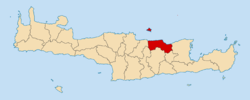Hersonissos
|
Hersonissos Χερσόνησος Chersónisos |
|
|---|---|

View of the city.
|
|
| Coordinates: 35°19′N 25°23.4′E / 35.317°N 25.3900°ECoordinates: 35°19′N 25°23.4′E / 35.317°N 25.3900°E | |
| Country | Greece |
| Administrative region | Crete |
| Regional unit | Heraklion |
| Government | |
| • Mayor | Ioannis Mastorakis |
| Area | |
| • Municipality | 272.2 km2 (105.1 sq mi) |
| • Municipal unit | 71.0 km2 (27.4 sq mi) |
| Elevation | 28 m (92 ft) |
| Population (2011) | |
| • Municipality | 26,717 |
| • Municipality density | 98/km2 (250/sq mi) |
| • Municipal unit | 8,262 |
| • Municipal unit density | 120/km2 (300/sq mi) |
| Community | |
| • Population | 3,165 (2011) |
| Time zone | EET (UTC+2) |
| • Summer (DST) | EEST (UTC+3) |
Hersonissos (Greek: Χερσόνησος(meaning peninsula), Chersónisos, pronounced [xerˈsonisos]), also transliterated as Chersonisos and Hersónisos, is a town and a municipality in the north of Crete, bordering the Mediterranean / Aegean Sea. This community is about 25 kilometers east of Heraklion and west of Agios Nikolaos. What is usually called Hersonissos is in fact its peninsula and harbour. It is part of the Heraklion regional unit. It is situated 25 km from the Heraklion airport and 27 km from the Heraklion port. The seat of the municipality is the village Gournes.
The seaside resort of Hersonissos is officially the Port of Hersonissos (Greek: Λιμένας Χερσόνησου, Liménas Chersónisou) in distinction to the village of Upper Hersonissos (Greek: Άνω Χερσόνησος, Ano Chersónisos) further inland. Through tourism, the port town developed from the small harbour which served the original village, now known as Old Hersonissos.
The ancient town of Chersonesus was important enough in the Roman province of Creta et Cyrenaica early to become a Christian bishopric, a suffragan of the metropolitan see of Gortyna.
The names of some of its bishops appear in extant documents: Anderius took part in the Council of Ephesus in 431; Longinus in the Robber Council of 449; Euphratas was a signatory of the letter sent by the bishops of the province to the emperor Leo I the Thracian in 458 after the killing of Proterius of Alexandria; Sisinnius was at the Trullan Council in 692; and another Sisinnius at the Second Council of Nicaea in 787.
...
Wikipedia


